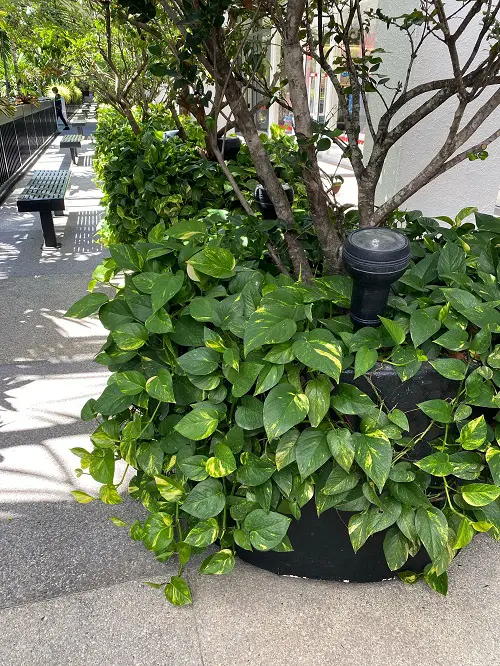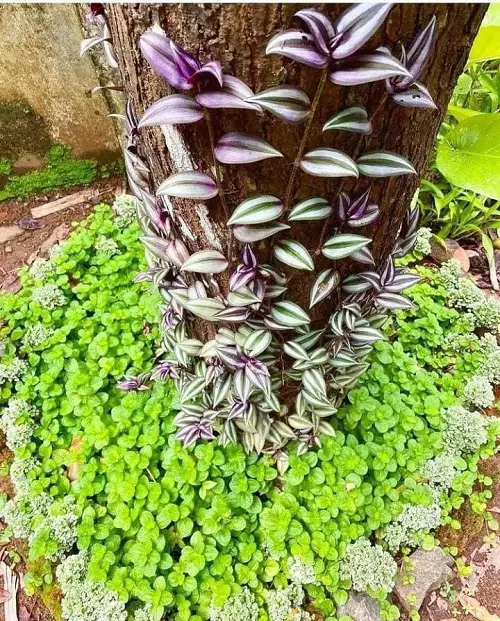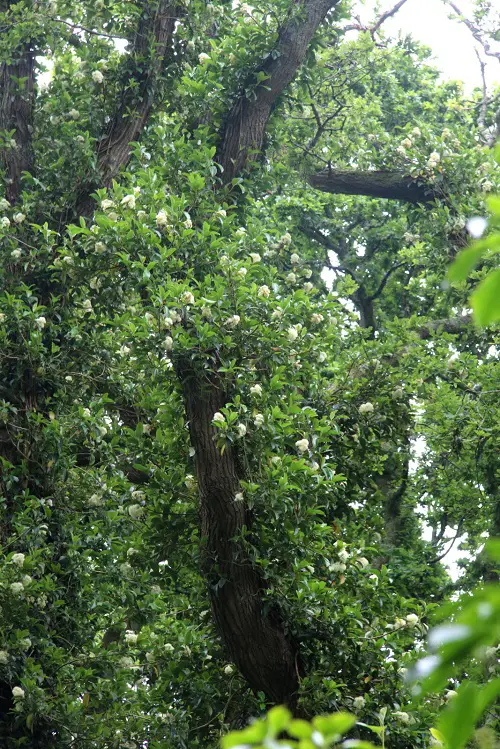We’ve gathered a list of 10 Best Clinging Vines That Climb on Anything! Perfect for filling up upright empty surfaces, check it out now!
Stuck looking at a boring wall? Or running low on floor space? These clinging vines are climbing ninjas that use sticky tendrils or disks to conquer any surface. Let’s go!
Best Clinging Vines That Climb on Anything
1. Pothos
Botanical Name: Epipremnum aureum
Easy to grow and super resilient, the humble Pothos kickstarts our list of clinging vines that climb anything! It shoots up using aerial roots that can plug into any surface that is shaded from the sun. However, it will need some support initially to cling to upright, smooth surfaces.
Train Pothos to overrun walls, decorate windowsills, border shelves, or scale up poles and trellises easily. And there are tons of varieties to choose from!
2. Climbing Fig

Botanical Name: Ficus pumila
Here’s a clinging vine that will climb on anything! Climbing Fig spreads vigorously and attaches itself to walls and trellises using sticky pads on its stems! In warm climes, it gets invasive and will need a regular trim.
It is not cold-hardy, however, and cannot survive frost. This wild climber is perfect for barren outdoor spots with no essential vegetation nearby, such as a garage entrance!
3. Boston Ivy

Botanical Name: Parthenocissus tricuspidata
This autumn classic scales any surface quickly via its dense network of aerial rootlets. These act like tiny suction cups that latch onto bumpy surfaces like rock, brick, stone, and wood and proliferate quickly.
4. Wandering Jew
Botanical Name: Tradescantia zebrina
With pretty purple, green, and silver foliage, the wandering dude is a house favorite! It uses its trailing stems to clamber up structures. While easy to grow, the creeper needs support, a bit of a tuck and trim, and a little TLC every now and again. Here’s how you train it!
5. Mini Monstera
Botanical Name: Rhaphidophora tetrasperma
Sporting large, glossy, split-edged leaves, mini monsteras have aerial roots that anchor onto surfaces and slowly move up. However, these roots are not as strong as the aerial roots of English Ivy or Climbing Fig.
Give it some physical support from trellises and poles to help it mount easily, especially indoors.
6. Clematis
Botanical Name: Clematis montana
While not all Clematis varieties are clingers, some, like Clematis montana, have strong, twining stems that wrap around structures and climb up walls and fences. Clematis are generally well-behaved vines and are not as aggressive as some of the other climbers on this list.
7. Virginia Creeper

Botanical Name: Parthenocissus quinquefolia
Virginia Creeper is a great choice for a clinging vine that can climb anything. Like English Ivy, it uses adhesive discs on its tendrils to cling to surfaces.
However, Virginia Creeper can also attach itself to smooth surfaces by secreting a sticky substance. This makes it a good option for crawling up brick, stucco, and even glass walls.
8. Hydrangea serratifolia

Botanical Name: Hydrangea serratifolia
This beautiful flowering vine sports large, serrated leaves and clusters of white flowers in summer. Hydrangea serratifolia is a self-clinging vine, but its clinging mechanism needs some encouragement.
It conquers rough surfaces like brick walls with ease, but needs support with smooth surfaces in the beginning, just like pothos.
9. Decumaria
Botanical Name: Decumaria Barbara
Here’s another flowering clinging vine for you–Decumaria. Also a self-clinging vine but its clinging ability is moderate. You’ll need to give it extra support if you want it to grow on smooth walls.
Decumaria barbara can be invasive in some areas, so be sure to check with your local authorities before planting.
10. English Ivy

Botanical Name: Hedera helix
English ivy is one of the best vines to cover unsightly walls as it is self-clinging; it won’t damage the structure, but if there are cracks and crevices, it can penetrate the aerial roots to support itself. If you’re ready to give it regular trimming to control invasiveness, you can easily grow it in full sun or shade.


